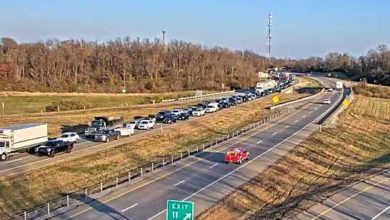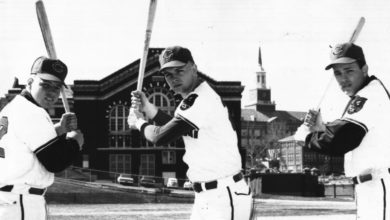

We know Cincinnati has been a popular place to make films – but what about books? This may not be New York, but there are enough novels set in Cincinnati to grab our attention. Some authors are local, some not. Some wrote about historical events, or changed the city’s name – but we know it’s really the Queen City. There are mysteries and romance and urban fantasy. Award winners and popular page-turners. There’s something for every reader. Here are a few Cincinnati novels you might want to add to your reading list.

“Uncle Tom’s Cabin” by Harriet Beecher Stowe (1852) – The literary classic helped to change readers’ minds about slavery in the years leading to the Civil War. Stowe was influenced by her experiences and observations while living in Cincinnati when her father was president of Lane Theological Seminary in Walnut Hills. The story of the runaway slave girl, Eliza, crossing the frozen Ohio River with her son was inspired by a real woman who crossed in 1838 and found protection in the home of John Rankin in Ripley, Ohio, a safe house on the Underground Railroad.
“Babbitt” by Sinclair Lewis (1922) – Lewis’ satirical jab at the middle class is set in the fictional Midwestern city Zenith. Many cities vied for the ignominious claim of being the inspiration for this city of hustlers, but Lewis kept a suite at the Queen City Club while he wrote the book, so we have a strong claim. Lewis thanked a friend for sending him to Cincinnati to write: “I am quite indebted to you for the material of the book. I am quite sure that none of our friends in Cincinnatti [sic] will ever know it.”

“Back Street” by Fannie Hurst (1930) – “One evening in one of those Over-the-Rhine cafés which were plentiful along Vine Street of the Cincinnati of the nineties, a traveling salesman leaned across his stein of Moerlein’s Extra Light and openly accused Ray Schmidt of being innocent.” That’s the 1890s, and that was Wielert’s Cafe. This melodramatic tale of a socialite who goes from a desirable companion to being cast into the “back streets” was so popular it was adapted to film four times.
“The Frontiersmen” by Allan W. Eckert (1967) – Eckert’s classic historic narrative of the conquest of the Northwest Territory in the early days of the settlements around Cincinnati uses imagined dialogue and internal thoughts of the characters, blurring fact and fiction a bit, but it is well researched and paints an engaging, honest portrayal of the tough men, particularly Simon Kenton, and the native Shawnee who grappled to tame the frontier.

“Beloved” by Toni Morrison (1987) – The Nobel laureate was awarded a Pulitzer Prize for her novel about Sethe, a former slave in Cincinnati who relives the trauma and tragedy of her past. Morrison was inspired by the real-life story of Margaret Garner, a runaway slave who chose to kill her own children rather than let them return to slavery. Morrison also wrote the libretto for the “Margaret Garner” opera.
“Cincinnati” by Lee Davis Willoughby (1990) – This historical novel in the tradition of John Jakes is part of the “Americana: The Making of the Cities” series. In the days of steamboats and racial strife just before the Civil War, a German immigrant family is torn apart by the issue of emancipation. The novel describes a long-ago city that was one of the most influential at the time.
“Queen City Jazz” by Kathleen Ann Goonan (1994) – In a dystopian future where nanotech plagues have decimated the population, Verity must bring her wounded friend to the legendary Enlivened City of Cincinnati, a place of legend where giant engineered bees are messengers. Did we mention this is science fiction?
“The Cincinnati Red Stalkings” by Troy Soos (1998) – In this baseball mystery, journeyman infielder Mickey Rawlings joins the 1921 Reds team and gets embroiled in a murder. There’s lots of baseball and Cincinnati history, with a focus on the 1869 Red Stockings, plus Reds greats Edd Roush, Heinie Groh and owner Garry Herrmann at old Redland Field (a.k.a. Crosley Field).
“The Jazz Bird” by Craig Holden (2002) – This historical novel tells the true-life story of Cincinnati bootlegger George Remus and the murder of his wife, Imogene, in Eden Park in 1927. Holden resurrects these larger-than-life characters along with the famous parties Remus threw at his Price Hill mansion. Or, check out the non-fiction books “The Bourbon King” by Bob Batchelor (2019) and “The Ghosts of Eden Park” by Karen Abbott (2019) on the same subject.

“Dead Witch Walking” by Kim Harrison (2004) – The first in the Hollows urban fantasy series is set in an alternate reality Cincinnati where witches, vampires and werewolves openly coexist with humans. The series follows the exploits of Rachel Morgan, a bounty hunter witch, in the Northern Kentucky suburb known as the Hollows, where the creatures of the night dwell.
“No Police Like Holmes” by Dan Andriacco (2011) – This is the first book in the Sebastian McCabe and Jeff Cody mystery series set in Erin, Ohio, a fictional Cincinnati suburb on the banks of the Ohio River. The series has the conceit of connections to Sherlock Holmes stories, but the amateur detective duo – a brilliant literature professor and his brother-in-law – is more akin to Nero Wolfe and Archie Goodwin. “Queen City Corpse” (2017) is set at a mystery convention held in Union Terminal.
“The History of Us” by Leah Stewart (2013) – A number of Cincinnati authors have recently set their stories in the Queen City. Stewart teaches creative writing at the University of Cincinnati. After her sister and brother-in-law are killed, Eloise Hempel must return to her family home, an aging Clifton mansion, to raise their three children.
“The Boy at the Museum” by Tamera Lenz Muente (2014) – Muente, an associate curator at the Taft Museum of Art, penned this novel about Enos, a boy without legs who is a live exhibit in Cincinnati’s museum of curiosities in 1843. The Western Museum was real, founded by Dr. Daniel Drake as a scientific museum with exhibits by John James Audubon that deteriorated into spectacle in later years.
“Eligible” by Curtis Sittenfeld (2016) – A modern-day retelling of Jane Austen’s “Pride and Prejudice” set in contemporary Cincinnati casts the Bennets in Hyde Park trying to marry off their daughters, Liz, a magazine writer, and Jane, a yoga instructor, to the surgeon Chip Bingley, who appeared on a reality show, and his friend, Darcy. Tons of Cincinnati references, from Skyline Chili to Christ Hospital.
“The Sweetest Fruits” by Monique Truong (2019) – Truong tells the stories of the women closest to writer (and former Enquirer reporter) Lafcadio Hearn, who in real life is celebrated for introducing Japanese folklore to the West. The novel’s three sections follow his Greek mother; his first wife, Alethea Foley, a former slave living in Cincinnati; and his second wife, Koizumi Setsu, in Japan.
“Other Words for Home” by Jasmine Warga (2019) – Jude and her mother have escaped from war-torn Syria to live with relatives in Cincinnati, near the mosque in Clifton. She finds America is different than the ’90s comedy movies she knows as she struggles with her new label of “Middle Eastern.” This book for young readers, written in free verse, was the winner of a 2020 Newbery Honor.
Source link







